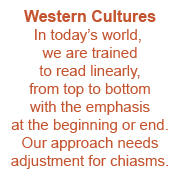Why You Should Study Chiasms
Here are five reasons why I think you should include the study of chiastic structures in your regular Bible reading.
I have stated elsewhere that the center point is often the most significant place of emphasis; this list provides a deeper perspective into the question, "Why study chiasms?"
As author of Joshua's Spiritual Warfare, I have studied the chiastic structure in the book of Joshua the most.
Therefore I am using that book to show the benefits of studying this topic.
1. Discover God's Emphasis

First and foremost, God through the Holy Spirit speaks in many varied and various ways.
One of those ways, and certainly a more sophisticated one, is through chiastic structures in the Bible.
As we read the Biblical text, we are reading from His heart.
His voice in the Bible is not an audible voice but a knowing voice–we know in our spirit the emphatic truth that is presented.
The chiastic approach reveals that emphatic voice indicating why He inspired the Biblical authors to write the passage in that manner.
Again, the questions should be asked, "Why is it there?" and "What does it say to me?"
- The message in Joshua 1:5 and then repeated in 1:9 is for you: I will never leave you nor forsake you.
- When the covenant was renewed between Mounts Gerizam and Ebal, chapter 8, the LORD was in the center.
- The center point of the treaty with the Gibeonites in chapter 9 indicates that they did not first inquire of the LORD
When the Lord speaks, whether audibly or through the written text, there are principles that can affect each of us. Study of chiastic structures can help that process.
2. Clarify the Text
What really happened at the Jordan River? The account in chapters three and four of Joshua has rightfully confused many readers. As one prominent commentator mused on these events, "The chronology becomes difficult to follow in several places." There is a great deal of repetition in these passages, but that is the structure that comes with chiasms – they are very repetitious. Looking at those passages with a chiastic eye should have helped that commentator and many others.
- When the Lord said to Joshua, "Do not fear and do not be dismayed" (Joshua 8:1), the chiasm shows how that promise was answered; it is a principle that can be applied to our lives.
- The altar that the eastern tribes built (chapter 22) has bothered many Bible readers. The associated chiasms uncover first Joshua's remedy and then Phinehas's wisdom.
- Joshua spoke these words to the Israelites: "You are not able to serve the Lord" (Joshua 24:19), the chiasm reveals at least one motive behind this often misinterpreted passage.
3. Correct Some Misunderstandings
The prostitute Rahab is identified as a woman of faith: "By faith Rahab the prostitute did not perish with those who were disobedient, because she had given a friendly welcome to the spies" (Hebrews 11:31). But there is another side to Rahab that is revealed in the chiastic structure – she had a deceptive spirit. One of the tensions that readers of Joshua must deal with is the apparent conflict between her lying behavior and her faithful statements. Some have even gone so far as to justify lying in certain circumstances, arguing that it was okay for Rahab to do so. Analyzing the chiasms in the second chapter of Joshua removes that justification for lying.
4. Throughout the Bible
Bible scholars have identified well over one thousand chiasms from Genesis to Revelation – I've identified sixty-seven in just the book of Joshua and I probably missed some. In that sense alone, the impressive number of chiastic structures is a good reason to study chiasms. While other literary structures exist in the Scriptures, it seems easy to find ourselves in the middle of a chiasm and not even know it.
5. Applies to any Language
Some people are intent on learning the ancient Greek, Hebrew and Aramaic that was used in the Bible. I suggest that this is really not practical for most people today. The beauty of studying the structured themes in chiasms is that this should work with any good translation: French if that is your language, Russian or Chinese if you prefer, as long as it is fairly literal. It is the themes, not the individual words, that make the corresponding pairs of the chiasm apparent.